Adidas' strategy in the market and the determinants affect the supply of adidas
Added on 2022-07-20
22 Pages5651 Words29 Views
Table of Contents
No. Item Page
1.1 Adidas’s background 1
1.2 Adidas’s goods / services 2
1.3 Five determinants of supply that affect the Adidas’s supply of goods:
1.3.1 Input prices 3
1.3.2 Expectation 4
1.3.3 Number of suppliers 5
1.3.4Technology 6
1.3.5Weather 7
1.4 Three determinants of price elasticity of demand that affect the
consumer’s demand of Adidas’s supply of good:
8
8-9
9
1.4.1 The availability of close substitutes
1.4.2 Luxury or necessity
1.4.3 The proportion of income spent onthe goods
2.1 Hong Kong’s Gross Domestic Product 10-12
2.2 Current economic challenges faced by Hong Kong and the ways to
overcome the problems 13-15
References 16-17
No. Item Page
1.1 Adidas’s background 1
1.2 Adidas’s goods / services 2
1.3 Five determinants of supply that affect the Adidas’s supply of goods:
1.3.1 Input prices 3
1.3.2 Expectation 4
1.3.3 Number of suppliers 5
1.3.4Technology 6
1.3.5Weather 7
1.4 Three determinants of price elasticity of demand that affect the
consumer’s demand of Adidas’s supply of good:
8
8-9
9
1.4.1 The availability of close substitutes
1.4.2 Luxury or necessity
1.4.3 The proportion of income spent onthe goods
2.1 Hong Kong’s Gross Domestic Product 10-12
2.2 Current economic challenges faced by Hong Kong and the ways to
overcome the problems 13-15
References 16-17
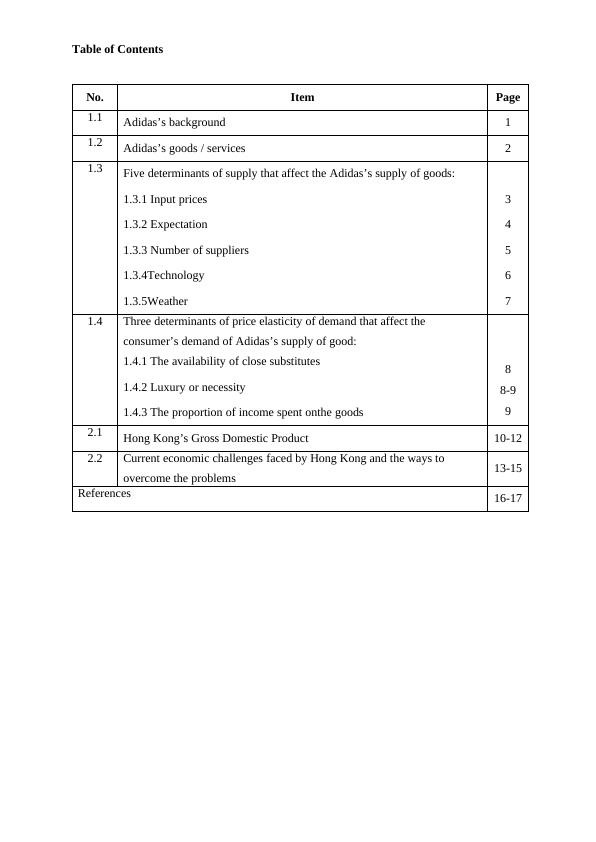
1.1 Adidas’s background
Adidasis a multinational company which has business operations or manufacture facilities in many countries across the world. Adidas is
headquartered in Herzogenaurach, Germany. This company designs,develops, manufactures and sells a broad range athletic and sport lifestyle
productall around the world.The company’stwo core brands are Adidas and Rebook.Now, Adidas is the biggest sportswear producer in Europe,
and the second biggest in the world, after Nike.
The founder of Adidas,Adolf Adi Dassler, started the business of makingshoes in his mother's wash kitchen. In 1924, his elder
brother Rudolf joined him and formed Dassler Brothers Shoe Factory (“GebrüderDasslerSchuhfabrik”). Dasslerassisted in the development of
spiked running shoes (spikes) for multiple athletic events. In 1949, following a breakdown in the relationship between Adolf and Rudolf,
Adolfregistered “Adi Dassler adidas Sportschuhfabrik” which is Adidas, and Rudolf created Puma, which became Adidas’s business rival.
Adidas has a mission which is to be the best sports company in the world, and their core belief is “through sport, we have the power to
change lives”. The 7 keys location of Adidas are the HQ inHerzogenaurach, Germany, Amsterdam, Portland, Boston, Shanghai, Hong Kong and
Panama.Recently, the CEO of Adidas is Kasper Rorsted, and the company has employed over 59,000 people from about100 countries.
In year 2019, Adidas produced over 1.1 billion sports and sports lifestyle products with independent manufacturing partners worldwide
and generated the sales of € 23,640 million. Compared with the net sales in 2018 which is € 21,915 million, it had increased 7.9%.The net
income of Adidas had increased by 16% which is from an amount of € 1,704 million in year 2018 to € 1,977 million in year 2019.
2
Adidasis a multinational company which has business operations or manufacture facilities in many countries across the world. Adidas is
headquartered in Herzogenaurach, Germany. This company designs,develops, manufactures and sells a broad range athletic and sport lifestyle
productall around the world.The company’stwo core brands are Adidas and Rebook.Now, Adidas is the biggest sportswear producer in Europe,
and the second biggest in the world, after Nike.
The founder of Adidas,Adolf Adi Dassler, started the business of makingshoes in his mother's wash kitchen. In 1924, his elder
brother Rudolf joined him and formed Dassler Brothers Shoe Factory (“GebrüderDasslerSchuhfabrik”). Dasslerassisted in the development of
spiked running shoes (spikes) for multiple athletic events. In 1949, following a breakdown in the relationship between Adolf and Rudolf,
Adolfregistered “Adi Dassler adidas Sportschuhfabrik” which is Adidas, and Rudolf created Puma, which became Adidas’s business rival.
Adidas has a mission which is to be the best sports company in the world, and their core belief is “through sport, we have the power to
change lives”. The 7 keys location of Adidas are the HQ inHerzogenaurach, Germany, Amsterdam, Portland, Boston, Shanghai, Hong Kong and
Panama.Recently, the CEO of Adidas is Kasper Rorsted, and the company has employed over 59,000 people from about100 countries.
In year 2019, Adidas produced over 1.1 billion sports and sports lifestyle products with independent manufacturing partners worldwide
and generated the sales of € 23,640 million. Compared with the net sales in 2018 which is € 21,915 million, it had increased 7.9%.The net
income of Adidas had increased by 16% which is from an amount of € 1,704 million in year 2018 to € 1,977 million in year 2019.
2
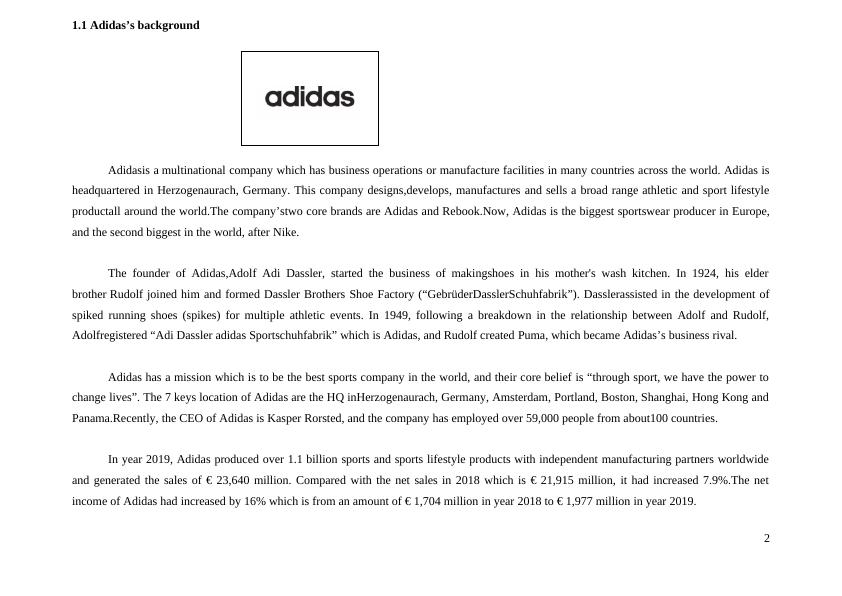
Picture 2Picture1
Picture 1: Adidas Ultra Boost 20 ‘Silver Metallic’ Picture 2: Runner tee ‘DGH Solid Grey’
(Net sales and net income refer to Appendix 1)
1.2 Adidas’sgood / services
One of the products of Adidas is Adidas Ultra Boost 20 shoes. Ultra Boost 20 shoes cost RM780 and it is first release in the 14th May
2020 with Primeblue adidas Ultra Boost 20 ‘White’. Later, Adidas release different colors such as gold metallic, silver metallic with the same
design in June and July 2020. There is a total of 22 colors available. Ultra Boost 20 shoes is a high performance running shoes with the
stretchweb outsole with Continental™ Rubber, snug and sock-like fit, lace shoe closure, adidas Primeknit plus textile upper, Tailored Fibre
Placement locked-in fit, weight is about 310 g and with a Midsole drop of 10 mm (heel 22 mm / forefoot 12 mm). The whole design of this
running shoes gives the best running experience to the runner. The design of Ultra Boost 20 midsole contains thousands of small energy capsules
that store and release more energy when running, helping the runner to boost their running performance.Themidsole also helps in support and
cushion the runner’s feet, giving a comfy feeling and do not hurt the runners’ feet and ankle while running.
In addition, Adidas also manufactures clothing products for sports such as the runner tee. Runner tee is a reflective running t-shirt,
crewneck designed, and it is made up of 100% recycled polyester that hasa smaller impact to the environment. It is sold at a price of RM150
with optional sizes and three colors available. The tee has been made with Primegreen,a high-performance fabric which contains no virgin
plastic.Adidas has introducesPrimegreen and Primeblue as sustainable technologies that contain 100% recycled polyester. Although it is made of
3
Picture 1: Adidas Ultra Boost 20 ‘Silver Metallic’ Picture 2: Runner tee ‘DGH Solid Grey’
(Net sales and net income refer to Appendix 1)
1.2 Adidas’sgood / services
One of the products of Adidas is Adidas Ultra Boost 20 shoes. Ultra Boost 20 shoes cost RM780 and it is first release in the 14th May
2020 with Primeblue adidas Ultra Boost 20 ‘White’. Later, Adidas release different colors such as gold metallic, silver metallic with the same
design in June and July 2020. There is a total of 22 colors available. Ultra Boost 20 shoes is a high performance running shoes with the
stretchweb outsole with Continental™ Rubber, snug and sock-like fit, lace shoe closure, adidas Primeknit plus textile upper, Tailored Fibre
Placement locked-in fit, weight is about 310 g and with a Midsole drop of 10 mm (heel 22 mm / forefoot 12 mm). The whole design of this
running shoes gives the best running experience to the runner. The design of Ultra Boost 20 midsole contains thousands of small energy capsules
that store and release more energy when running, helping the runner to boost their running performance.Themidsole also helps in support and
cushion the runner’s feet, giving a comfy feeling and do not hurt the runners’ feet and ankle while running.
In addition, Adidas also manufactures clothing products for sports such as the runner tee. Runner tee is a reflective running t-shirt,
crewneck designed, and it is made up of 100% recycled polyester that hasa smaller impact to the environment. It is sold at a price of RM150
with optional sizes and three colors available. The tee has been made with Primegreen,a high-performance fabric which contains no virgin
plastic.Adidas has introducesPrimegreen and Primeblue as sustainable technologies that contain 100% recycled polyester. Although it is made of
3

recycled material, the tee is comfortable, soft and breathable. The runner tee in not only giving a fashion and sporty look while wearing it, but
also regular fits and strikes a comfortable balance between loose and snug.
1.3 Five determinants of supply that affect Adidas’s supply of goods
1.3.1 Input prices
The inputsused in the production of goods and services arealso known as factors of production,for example:labour, capital, land and
entrepreneurship. Lower input prices will decrease the cost of production, causing an increase in the supply of goods or services. Whereas, if the
input prices are higher, the cost of production will increase and causing the supply of a good to decrease. Adidas reducestheir input pricesfor
their products so that the cost of production will be lower. When the cost of production is lower, Adidas can earn more profit as the products are
more profitable.Therefore, Adidas will supply more products to its consumersto earn more money and the supply curve will shift rightwards.
Adidas used recycled materials in their production that have a lower price compared to other expenses advanced material. Adidas produce
more than 5 million shoes that involving the use of the recycled material. The upcycled plastic waste is made into a yarn that is a key component
of the upper material of adidas footwear without purchasing expensive advanced materials. For example, recycled polyester (rPES) is a synthetic
fiber that consisting of waste, including plastic bottles and used garments. Although the products are making from recycle materials, Adidas still
could produce high performance footwear. The materials that use in production are sustainable cotton, recycled polyester, recycled nylon,
recycled rubber, algae-based EVA, TENCEL, water-based polyurethane (PU), and recycled thermoplastic polyurethane (TPU).
Adidas also uses natural fibers like cottons, leather, synthetics, recycled polyester, recycled rubber, and wool in footwear production. They
obtained the production materials they needed from other countries. Most of the factories that supply the raw materials are in Asia countries such
as Pakistan, India, Indonesia, and Vietnam. These countries have enough labour to support the demand so that the cost of labour is lower as
4
also regular fits and strikes a comfortable balance between loose and snug.
1.3 Five determinants of supply that affect Adidas’s supply of goods
1.3.1 Input prices
The inputsused in the production of goods and services arealso known as factors of production,for example:labour, capital, land and
entrepreneurship. Lower input prices will decrease the cost of production, causing an increase in the supply of goods or services. Whereas, if the
input prices are higher, the cost of production will increase and causing the supply of a good to decrease. Adidas reducestheir input pricesfor
their products so that the cost of production will be lower. When the cost of production is lower, Adidas can earn more profit as the products are
more profitable.Therefore, Adidas will supply more products to its consumersto earn more money and the supply curve will shift rightwards.
Adidas used recycled materials in their production that have a lower price compared to other expenses advanced material. Adidas produce
more than 5 million shoes that involving the use of the recycled material. The upcycled plastic waste is made into a yarn that is a key component
of the upper material of adidas footwear without purchasing expensive advanced materials. For example, recycled polyester (rPES) is a synthetic
fiber that consisting of waste, including plastic bottles and used garments. Although the products are making from recycle materials, Adidas still
could produce high performance footwear. The materials that use in production are sustainable cotton, recycled polyester, recycled nylon,
recycled rubber, algae-based EVA, TENCEL, water-based polyurethane (PU), and recycled thermoplastic polyurethane (TPU).
Adidas also uses natural fibers like cottons, leather, synthetics, recycled polyester, recycled rubber, and wool in footwear production. They
obtained the production materials they needed from other countries. Most of the factories that supply the raw materials are in Asia countries such
as Pakistan, India, Indonesia, and Vietnam. These countries have enough labour to support the demand so that the cost of labour is lower as
4
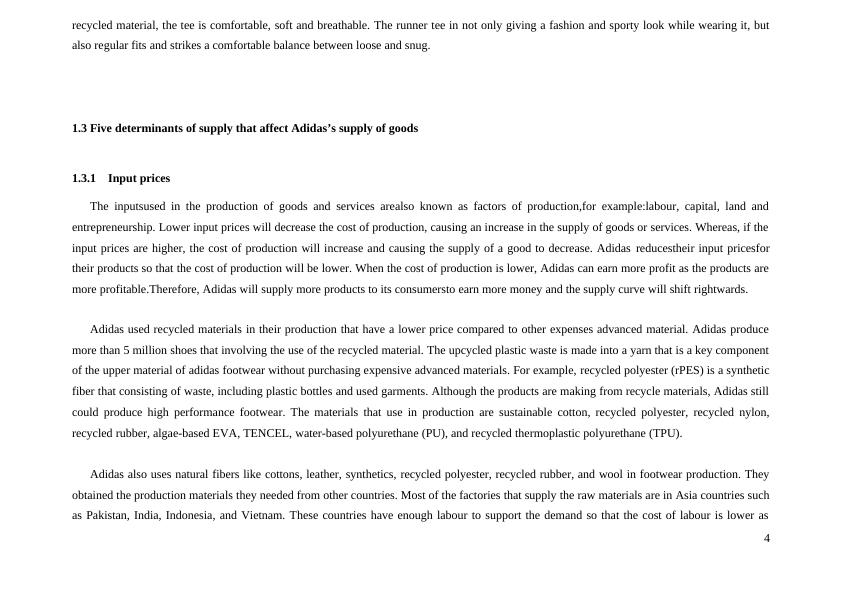
compare to other countries. Adidas can reduce the cost of labour for planting, fertilizing, and collecting raw materials by purchasing in related
countries. Therefore, Adidas can reduce the input prices with purchasing raw materials in these countries instead of planting in German that
requires high cost of labour.
(supporting documents: refer to Appendix 2)
1.3.2 Expectations
Expectations are one of the determinants of supply.When a company expects a higher price in the future, the company will tend to decrease
its current supply of goods to the market so that it could supply more during the phase of increase in price. This causes the supply graph of the
company to either shift to the left of right. This is due, the producers are willing to wait and supply during the phase of increase in price just to
maximize the profit that the company gets as goods will be more valuable. Similarly, when the company expects the price of its goods to reduce
in the future, it will tend to increase its current supply in order to get a higher profit while the price is still high.
If the expected future price of Adidas shoes, Jersey or other things under the brand increases, the supply of the clothes or shoes under the
brand of Adidas will decrease and the supply curve will shift leftwards. Adidas will decrease their products today so that they will have
sufficient supply in the future, and they can earn more profits when the prices of shoes are high.
Adidas will have higher prices in the next five years because the labor cost willincrease. Therefore, during the current time, Adidas will try to
supply less as they expected to rise their price in the future. This strategy is able to help them to supply more during the high price and earn more
money during that year.
(Supporting Document: refer to Appendix 3)
5
countries. Therefore, Adidas can reduce the input prices with purchasing raw materials in these countries instead of planting in German that
requires high cost of labour.
(supporting documents: refer to Appendix 2)
1.3.2 Expectations
Expectations are one of the determinants of supply.When a company expects a higher price in the future, the company will tend to decrease
its current supply of goods to the market so that it could supply more during the phase of increase in price. This causes the supply graph of the
company to either shift to the left of right. This is due, the producers are willing to wait and supply during the phase of increase in price just to
maximize the profit that the company gets as goods will be more valuable. Similarly, when the company expects the price of its goods to reduce
in the future, it will tend to increase its current supply in order to get a higher profit while the price is still high.
If the expected future price of Adidas shoes, Jersey or other things under the brand increases, the supply of the clothes or shoes under the
brand of Adidas will decrease and the supply curve will shift leftwards. Adidas will decrease their products today so that they will have
sufficient supply in the future, and they can earn more profits when the prices of shoes are high.
Adidas will have higher prices in the next five years because the labor cost willincrease. Therefore, during the current time, Adidas will try to
supply less as they expected to rise their price in the future. This strategy is able to help them to supply more during the high price and earn more
money during that year.
(Supporting Document: refer to Appendix 3)
5
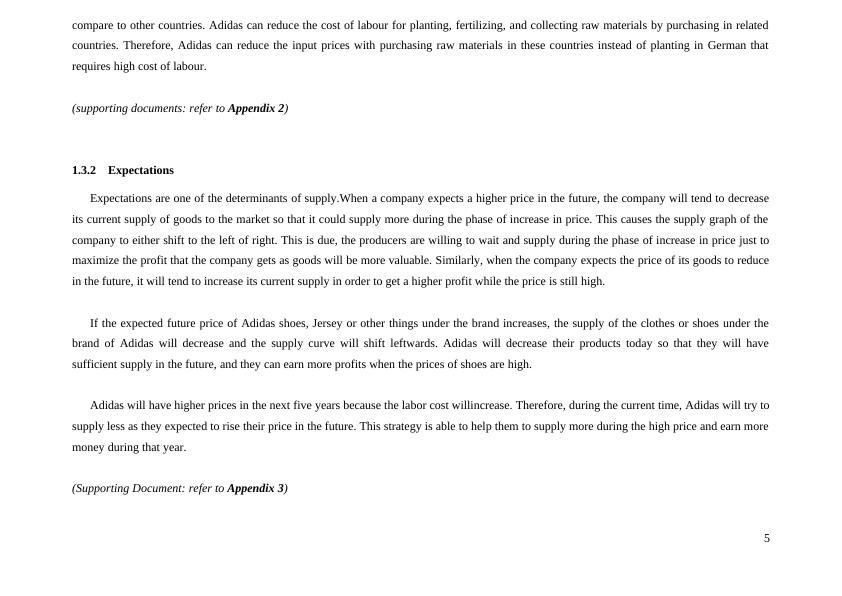
1.3.3 Number of suppliers
Based on Adidas’s announcement, its intention to move its Speedfactory technology to Asia, Adidas has outsourced most of its
production and working with around 631 independent worldwide manufacturing products in 52 countries. Most of their suppliers’ factories are
located at the Asia-Pacific region, America, and EMEA.
It has a global and multilayered supply chain with several types of suppliers in the chain, some of which are direct contractors, and many
are not. Besides, the major suppliers have a contractual relationship with Adidas to provide products for export or domestic market consumption.
Then, the subcontractors are subcontracted by Adidas suppliers to perform manufacturing operations that cannot be completed by the main
suppliers. Materials and other service providers are those suppliers that don’t have a direct business relationship with Adidas but they supply
goods and services to the main suppliers.
6
Based on Adidas’s announcement, its intention to move its Speedfactory technology to Asia, Adidas has outsourced most of its
production and working with around 631 independent worldwide manufacturing products in 52 countries. Most of their suppliers’ factories are
located at the Asia-Pacific region, America, and EMEA.
It has a global and multilayered supply chain with several types of suppliers in the chain, some of which are direct contractors, and many
are not. Besides, the major suppliers have a contractual relationship with Adidas to provide products for export or domestic market consumption.
Then, the subcontractors are subcontracted by Adidas suppliers to perform manufacturing operations that cannot be completed by the main
suppliers. Materials and other service providers are those suppliers that don’t have a direct business relationship with Adidas but they supply
goods and services to the main suppliers.
6
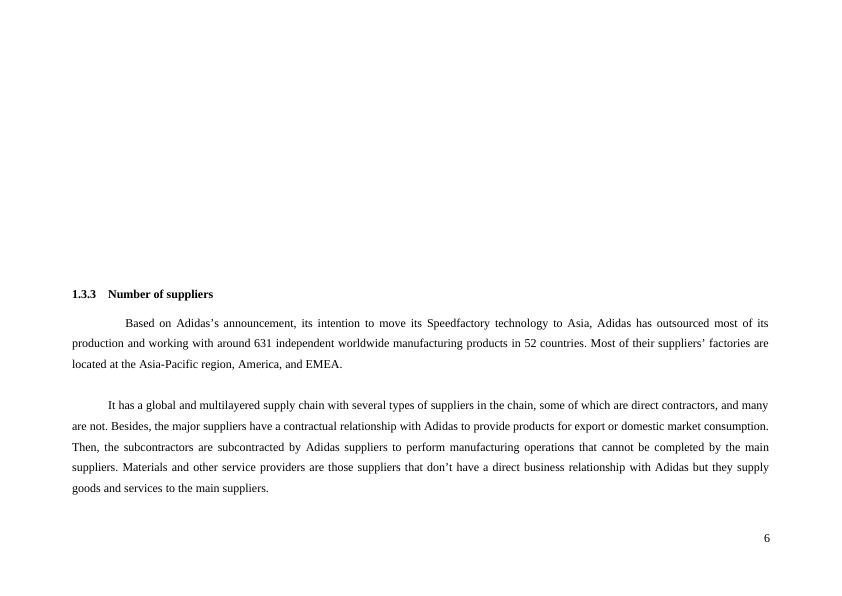
End of preview
Want to access all the pages? Upload your documents or become a member.
Related Documents
Marketing - Analysis of Adidas in Chinalg...
|23
|6000
|31
Business Environment Assignment - Adidaslg...
|12
|3302
|157
